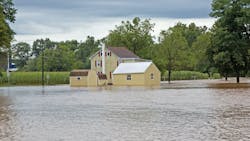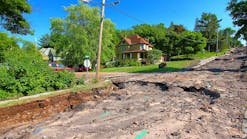New Jersey releases new flood risk forms, tools for homeowners, tenants
New Jersey officials have unveiled new property disclosure forms notifying prospective homeowners and renters of a property’s flood history and flood risks, as well as the launch of a search tool that identifies properties in flood hazard areas.
Sellers and landlords will be required to use the new forms, which are now available online, beginning on March 20, 2024. The new forms and tools will help prospective buyers and tenants choose where they live and learn how best to protect their property from flood damage.
The measures implement provisions of flood risk disclosure legislation signed into law by Governor Phil Murphy in June 2023.
“As we continue to live with the impacts of climate change in our communities, it’s essential that we inform prospective homebuyers and renters of the risks in areas where they are looking to settle down,” said Murphy. “These new protections will enable prospective home buyers and renters to stay a step ahead when it comes to finding the safest residence possible for themselves and their families.”
Prior to the adoption of New Jersey’s flood risk disclosure law, sellers and landlords were under no obligation to disclose a property’s flood history to potential buyers and tenants or inform them if the property was located in a Federal Emergency Management Agency (FEMA) Flood Hazard Zone Area. Now, they must make those disclosures prior to the signing of sales contracts, leases and lease renewals.
Updated property condition disclosure statement
In accordance with the requirements of the flood disclosure law, the Division of Consumer Affairs, in consultation with the New Jersey Real Estate Commission, today released an updated version of New Jersey’s Seller’s Property Condition Disclosure Statement, a required form in which sellers of residential properties report any defects or problems with the residence to potential buyers.
Under a new heading entitled “Flood Risk,” the updated disclosure form requires sellers to answer questions focusing on a property’s flood history and potential flood risk. Questions include whether a property is located within the FEMA’s Special Flood Hazard Area (“100-year floodplain”) or Moderate Risk Flood Hazard Area (“500-year floodplain”), whether the property has experienced flood damage or pooled water due to heavy rainfall or other natural flood event, and if the property is subject to any requirement under federal law to obtain and maintain flood insurance.
Rental flood risk notice
Also in accordance with the flood disclosure law, the Department of Community Affairs today posted on its website a model notice to be used by landlords to inform their tenants of the flood risk of rental properties. The model notice, which will also be published in the New Jersey Register, contains questions about the flood risk of the property and space for landlords to answer yes, no, or unknown, based upon the landlord’s actual knowledge. The model notice also contains basic information about flood insurance available to renters through FEMA’s National Flood Insurance Program and about the effects of climate change on flood risks in New Jersey.
Landlords must notify tenants in writing of the flood risk prior to lease signing or lease renewal effective 90 days after the Department of Community Affairs publishes the model notice. The Rental Flood Risk Notice can be found on the Department of Community Affairs website at https://nj.gov/dca/codes/offices/landlord_tenant_information.shtml and https://nj.gov/dca/dhcr/index.shtml.
Flood risk notification tool
To assist individuals with meeting the FEMA Flood Hazard Area disclosure requirements, the Department of Environmental Protection developed the Flood Risk Notification Tool. This online tool enables users to search properties by mailing address to identify whether the property overlaps with the FEMA Special or Moderate Flood Hazard Areas.
Users can also view additional flood risk information that is not required for disclosure but that provides a fuller picture of a property’s flood risk, including information on sea-level rise projections of 3 feet (likely by 2070) and 5 feet (likely by 2100).
The tool offers users the ability to view a property’s flood risk using the map legend and sidebar or request a detailed flood report to be emailed to them. The report includes the property’s FEMA flood zone information to satisfy the new disclosure requirements as well as a description of what FEMA flood zones mean and how they are determined.
The Flood Risk Notification Tool, links to both disclosure forms, and information on how climate and flood risks are changing in New Jersey can be found at https://flooddisclosure.nj.gov/.






